Factors Contributing to Job Satisfaction and Employee Retention
VerifiedAdded on 2020/04/15
|98
|18225
|53
Thesis and Dissertation
AI Summary
This dissertation investigates the critical factors contributing to job satisfaction among employees in Dubai's private sector and their subsequent impact on employee retention. The research delves into the current challenges faced by Dubai-based private companies regarding low employee retention rates, often attributed to insufficient job satisfaction. The study aims to identify key elements influencing employee satisfaction and retention, including salary, work environment, leadership, and career development opportunities. The methodology involves a literature review, a survey of 50 private sector employees, and data analysis using SPSS. The findings highlight the significance of job security, employee benefits, and morale in fostering retention. The dissertation concludes with recommendations for improving job satisfaction through strategies such as the PRIDE system, ultimately aiming to enhance employee retention and organizational performance within the Dubai private sector. The study covers various aspects, including research background, problem statement, research aim, research objectives, research questions, and research methodology. The findings are discussed in detail, and the dissertation concludes with recommendations and suggestions for future research.
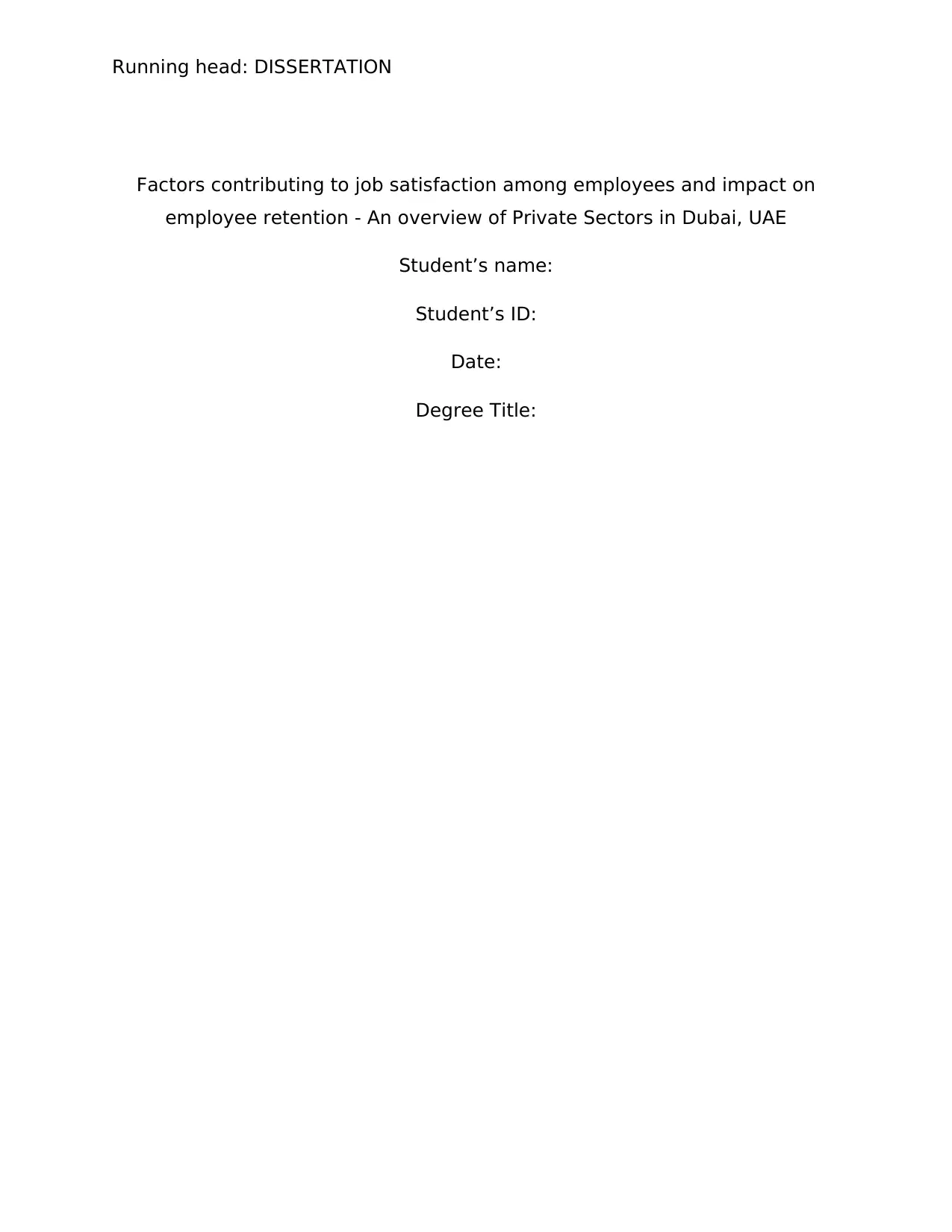
Running head: DISSERTATION
Factors contributing to job satisfaction among employees and impact on
employee retention - An overview of Private Sectors in Dubai, UAE
Student’s name:
Student’s ID:
Date:
Degree Title:
Factors contributing to job satisfaction among employees and impact on
employee retention - An overview of Private Sectors in Dubai, UAE
Student’s name:
Student’s ID:
Date:
Degree Title:
Paraphrase This Document
Need a fresh take? Get an instant paraphrase of this document with our AI Paraphraser
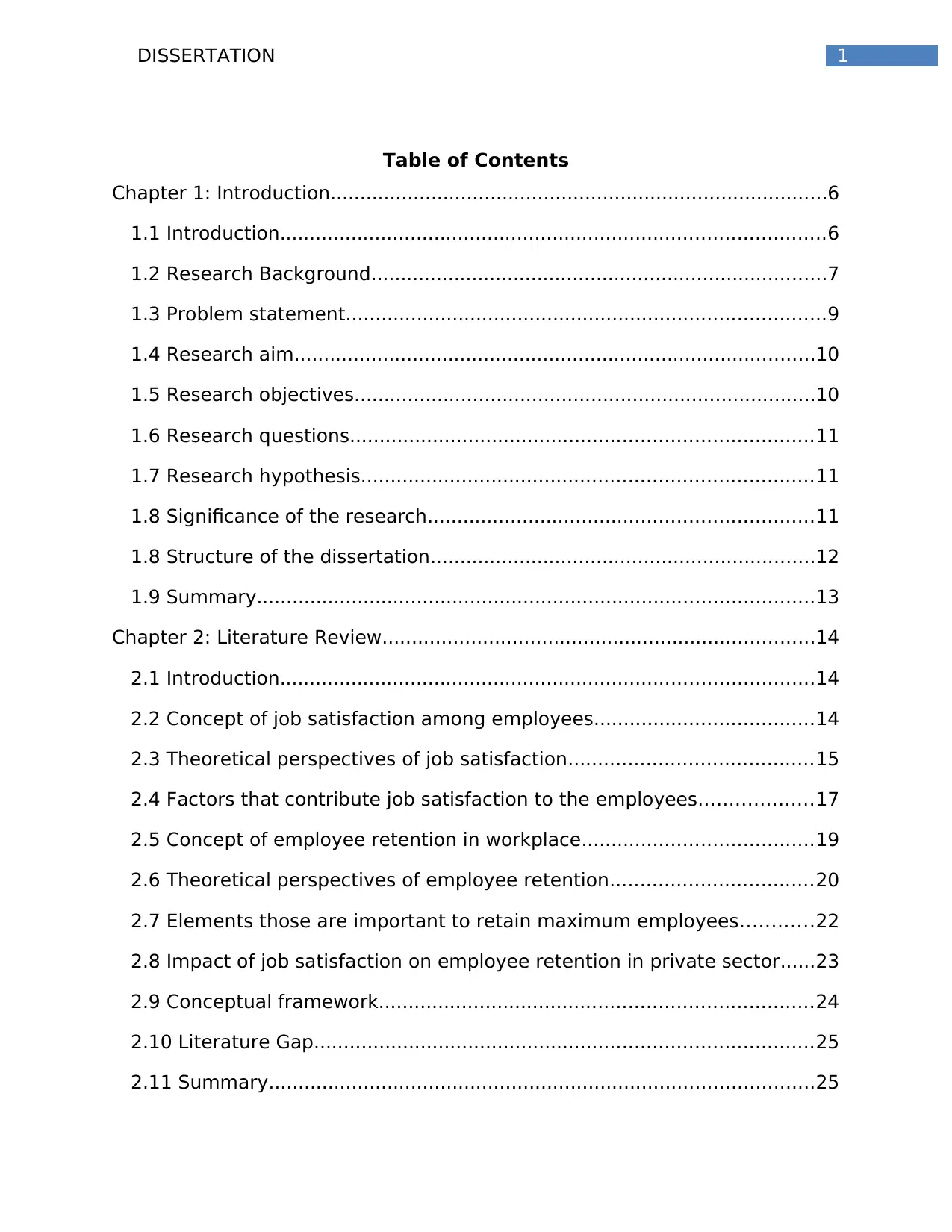
1DISSERTATION
Table of Contents
Chapter 1: Introduction....................................................................................6
1.1 Introduction............................................................................................6
1.2 Research Background.............................................................................7
1.3 Problem statement.................................................................................9
1.4 Research aim........................................................................................10
1.5 Research objectives..............................................................................10
1.6 Research questions..............................................................................11
1.7 Research hypothesis............................................................................11
1.8 Significance of the research.................................................................11
1.8 Structure of the dissertation.................................................................12
1.9 Summary..............................................................................................13
Chapter 2: Literature Review.........................................................................14
2.1 Introduction..........................................................................................14
2.2 Concept of job satisfaction among employees.....................................14
2.3 Theoretical perspectives of job satisfaction.........................................15
2.4 Factors that contribute job satisfaction to the employees...................17
2.5 Concept of employee retention in workplace.......................................19
2.6 Theoretical perspectives of employee retention..................................20
2.7 Elements those are important to retain maximum employees............22
2.8 Impact of job satisfaction on employee retention in private sector......23
2.9 Conceptual framework.........................................................................24
2.10 Literature Gap....................................................................................25
2.11 Summary............................................................................................25
Table of Contents
Chapter 1: Introduction....................................................................................6
1.1 Introduction............................................................................................6
1.2 Research Background.............................................................................7
1.3 Problem statement.................................................................................9
1.4 Research aim........................................................................................10
1.5 Research objectives..............................................................................10
1.6 Research questions..............................................................................11
1.7 Research hypothesis............................................................................11
1.8 Significance of the research.................................................................11
1.8 Structure of the dissertation.................................................................12
1.9 Summary..............................................................................................13
Chapter 2: Literature Review.........................................................................14
2.1 Introduction..........................................................................................14
2.2 Concept of job satisfaction among employees.....................................14
2.3 Theoretical perspectives of job satisfaction.........................................15
2.4 Factors that contribute job satisfaction to the employees...................17
2.5 Concept of employee retention in workplace.......................................19
2.6 Theoretical perspectives of employee retention..................................20
2.7 Elements those are important to retain maximum employees............22
2.8 Impact of job satisfaction on employee retention in private sector......23
2.9 Conceptual framework.........................................................................24
2.10 Literature Gap....................................................................................25
2.11 Summary............................................................................................25

2DISSERTATION
Chapter 3: Research Methodology.................................................................26
3.1 Introduction..........................................................................................26
3.2 Research Onion....................................................................................26
3.2 Research Philosophy.............................................................................27
3.3 Research Approach...............................................................................28
3.4 Research Purposes...............................................................................30
3.5 Research Strategy................................................................................30
3.6 Data collection methods.......................................................................31
3.7 Sampling method and technique..........................................................31
3.8 Data analysis techniques......................................................................32
3.9 Ethical considerations...........................................................................33
3.10 Reliability and validity of data............................................................33
3.11 Limitations..........................................................................................34
3.13 Timescale...........................................................................................34
3.14 Summary............................................................................................34
Chapter 4: Data findings and analysis...........................................................36
4.1 Introduction..........................................................................................36
4.2 Discussion.............................................................................................36
4.3 Summary..............................................................................................65
Chapter 5: Conclusions and Recommendations............................................67
5.1 Conclusions..........................................................................................67
5.2 Linking with objectives.........................................................................68
5.3 Recommendations................................................................................70
5.4 Future scope of the study.....................................................................75
Reference List................................................................................................77
Chapter 3: Research Methodology.................................................................26
3.1 Introduction..........................................................................................26
3.2 Research Onion....................................................................................26
3.2 Research Philosophy.............................................................................27
3.3 Research Approach...............................................................................28
3.4 Research Purposes...............................................................................30
3.5 Research Strategy................................................................................30
3.6 Data collection methods.......................................................................31
3.7 Sampling method and technique..........................................................31
3.8 Data analysis techniques......................................................................32
3.9 Ethical considerations...........................................................................33
3.10 Reliability and validity of data............................................................33
3.11 Limitations..........................................................................................34
3.13 Timescale...........................................................................................34
3.14 Summary............................................................................................34
Chapter 4: Data findings and analysis...........................................................36
4.1 Introduction..........................................................................................36
4.2 Discussion.............................................................................................36
4.3 Summary..............................................................................................65
Chapter 5: Conclusions and Recommendations............................................67
5.1 Conclusions..........................................................................................67
5.2 Linking with objectives.........................................................................68
5.3 Recommendations................................................................................70
5.4 Future scope of the study.....................................................................75
Reference List................................................................................................77
⊘ This is a preview!⊘
Do you want full access?
Subscribe today to unlock all pages.

Trusted by 1+ million students worldwide

3DISSERTATION
Appendices....................................................................................................85
Appendix 1.................................................................................................85
Appendix 2.................................................................................................86
Appendix 3.................................................................................................92
Appendices....................................................................................................85
Appendix 1.................................................................................................85
Appendix 2.................................................................................................86
Appendix 3.................................................................................................92
Paraphrase This Document
Need a fresh take? Get an instant paraphrase of this document with our AI Paraphraser
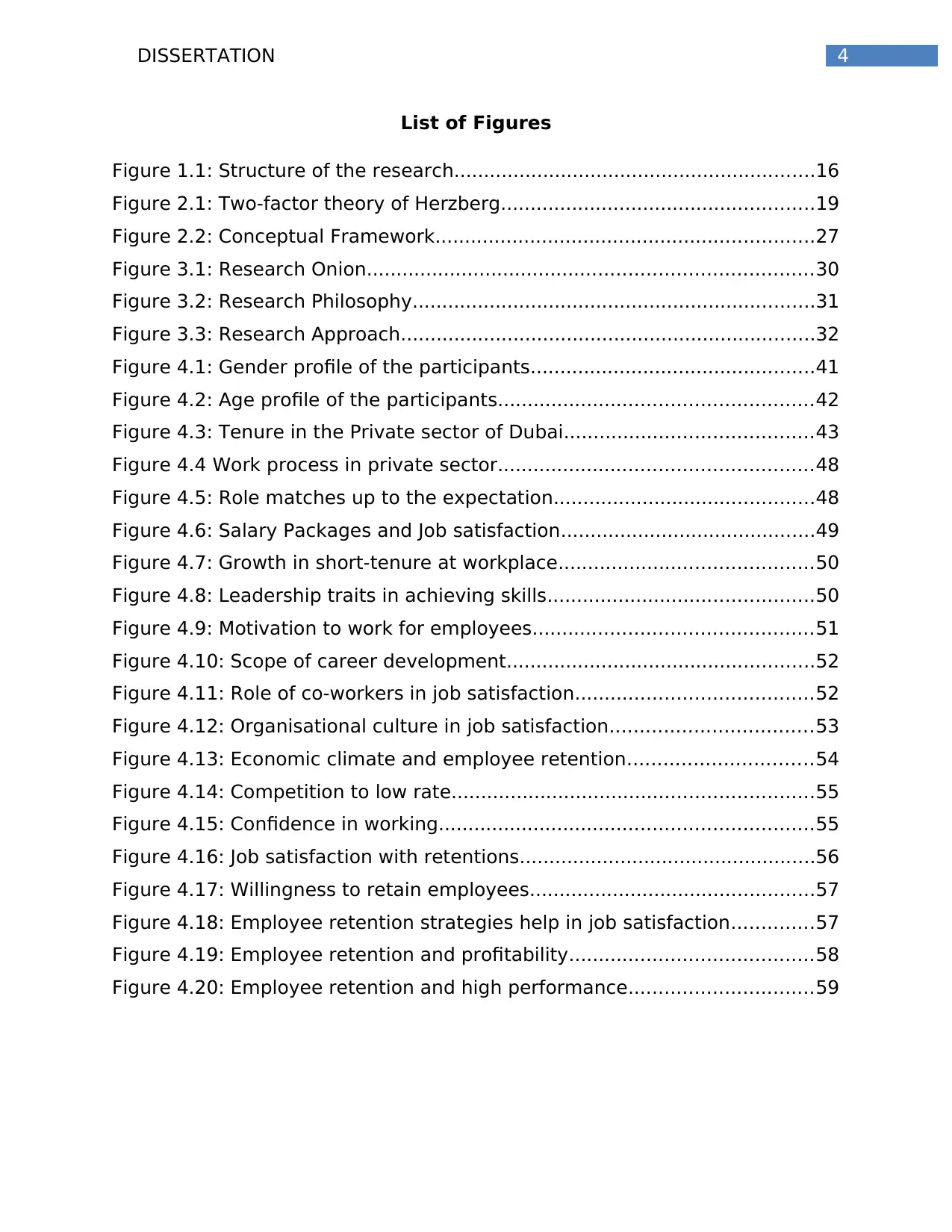
4DISSERTATION
List of Figures
Figure 1.1: Structure of the research.............................................................16
Figure 2.1: Two-factor theory of Herzberg.....................................................19
Figure 2.2: Conceptual Framework................................................................27
Figure 3.1: Research Onion...........................................................................30
Figure 3.2: Research Philosophy....................................................................31
Figure 3.3: Research Approach......................................................................32
Figure 4.1: Gender profile of the participants................................................41
Figure 4.2: Age profile of the participants.....................................................42
Figure 4.3: Tenure in the Private sector of Dubai..........................................43
Figure 4.4 Work process in private sector.....................................................48
Figure 4.5: Role matches up to the expectation............................................48
Figure 4.6: Salary Packages and Job satisfaction...........................................49
Figure 4.7: Growth in short-tenure at workplace...........................................50
Figure 4.8: Leadership traits in achieving skills.............................................50
Figure 4.9: Motivation to work for employees...............................................51
Figure 4.10: Scope of career development....................................................52
Figure 4.11: Role of co-workers in job satisfaction........................................52
Figure 4.12: Organisational culture in job satisfaction..................................53
Figure 4.13: Economic climate and employee retention...............................54
Figure 4.14: Competition to low rate.............................................................55
Figure 4.15: Confidence in working...............................................................55
Figure 4.16: Job satisfaction with retentions..................................................56
Figure 4.17: Willingness to retain employees................................................57
Figure 4.18: Employee retention strategies help in job satisfaction..............57
Figure 4.19: Employee retention and profitability.........................................58
Figure 4.20: Employee retention and high performance...............................59
List of Figures
Figure 1.1: Structure of the research.............................................................16
Figure 2.1: Two-factor theory of Herzberg.....................................................19
Figure 2.2: Conceptual Framework................................................................27
Figure 3.1: Research Onion...........................................................................30
Figure 3.2: Research Philosophy....................................................................31
Figure 3.3: Research Approach......................................................................32
Figure 4.1: Gender profile of the participants................................................41
Figure 4.2: Age profile of the participants.....................................................42
Figure 4.3: Tenure in the Private sector of Dubai..........................................43
Figure 4.4 Work process in private sector.....................................................48
Figure 4.5: Role matches up to the expectation............................................48
Figure 4.6: Salary Packages and Job satisfaction...........................................49
Figure 4.7: Growth in short-tenure at workplace...........................................50
Figure 4.8: Leadership traits in achieving skills.............................................50
Figure 4.9: Motivation to work for employees...............................................51
Figure 4.10: Scope of career development....................................................52
Figure 4.11: Role of co-workers in job satisfaction........................................52
Figure 4.12: Organisational culture in job satisfaction..................................53
Figure 4.13: Economic climate and employee retention...............................54
Figure 4.14: Competition to low rate.............................................................55
Figure 4.15: Confidence in working...............................................................55
Figure 4.16: Job satisfaction with retentions..................................................56
Figure 4.17: Willingness to retain employees................................................57
Figure 4.18: Employee retention strategies help in job satisfaction..............57
Figure 4.19: Employee retention and profitability.........................................58
Figure 4.20: Employee retention and high performance...............................59
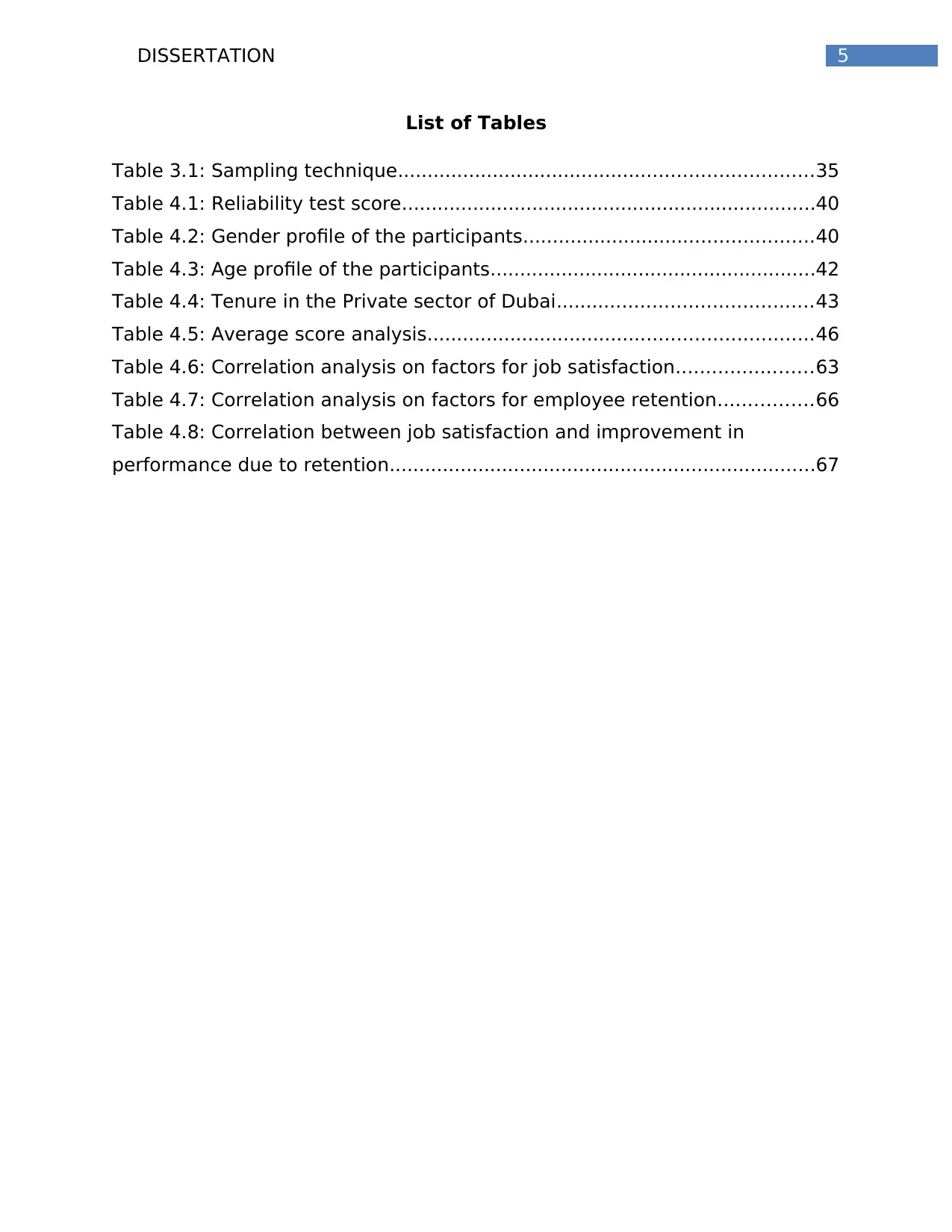
5DISSERTATION
List of Tables
Table 3.1: Sampling technique......................................................................35
Table 4.1: Reliability test score......................................................................40
Table 4.2: Gender profile of the participants.................................................40
Table 4.3: Age profile of the participants.......................................................42
Table 4.4: Tenure in the Private sector of Dubai...........................................43
Table 4.5: Average score analysis.................................................................46
Table 4.6: Correlation analysis on factors for job satisfaction.......................63
Table 4.7: Correlation analysis on factors for employee retention................66
Table 4.8: Correlation between job satisfaction and improvement in
performance due to retention........................................................................67
List of Tables
Table 3.1: Sampling technique......................................................................35
Table 4.1: Reliability test score......................................................................40
Table 4.2: Gender profile of the participants.................................................40
Table 4.3: Age profile of the participants.......................................................42
Table 4.4: Tenure in the Private sector of Dubai...........................................43
Table 4.5: Average score analysis.................................................................46
Table 4.6: Correlation analysis on factors for job satisfaction.......................63
Table 4.7: Correlation analysis on factors for employee retention................66
Table 4.8: Correlation between job satisfaction and improvement in
performance due to retention........................................................................67
⊘ This is a preview!⊘
Do you want full access?
Subscribe today to unlock all pages.

Trusted by 1+ million students worldwide
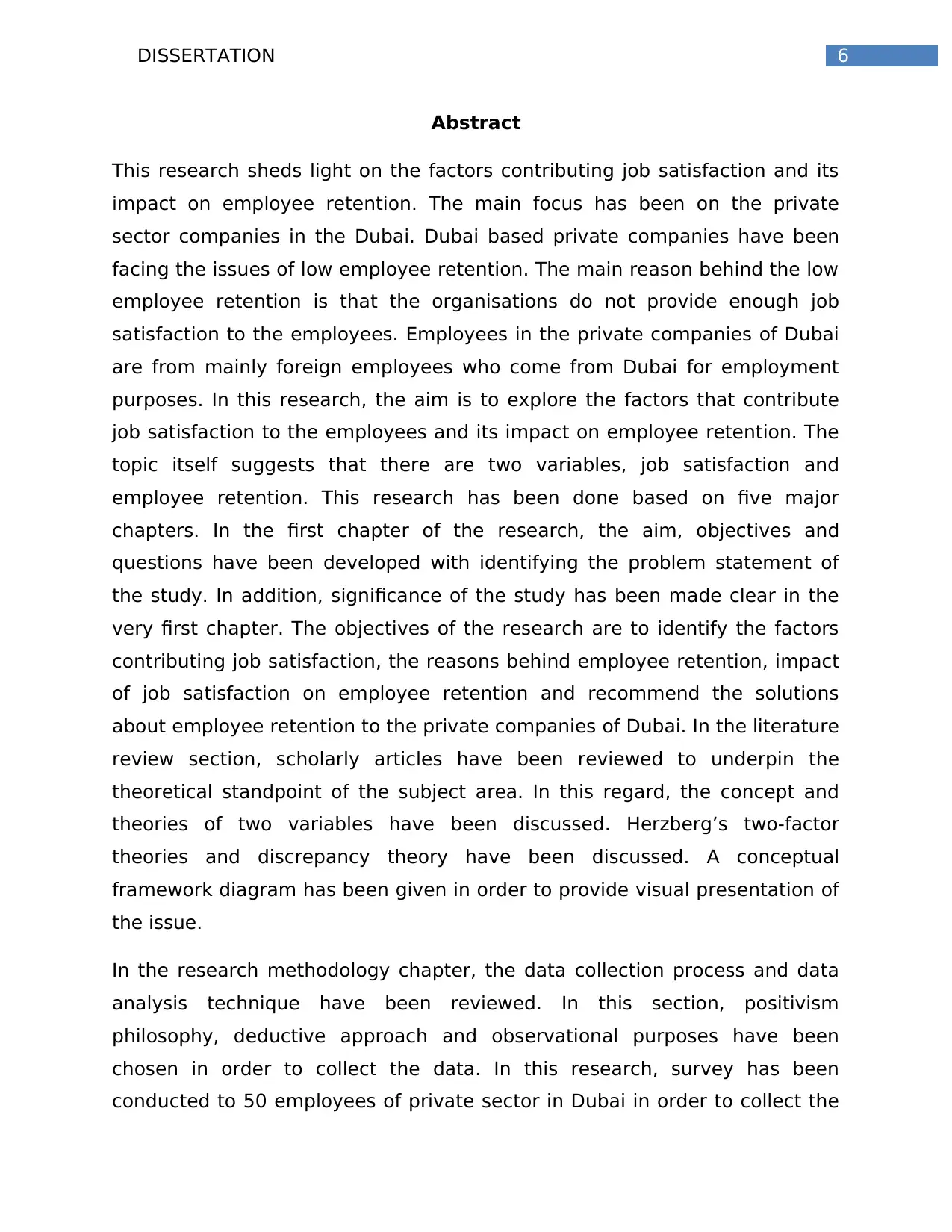
6DISSERTATION
Abstract
This research sheds light on the factors contributing job satisfaction and its
impact on employee retention. The main focus has been on the private
sector companies in the Dubai. Dubai based private companies have been
facing the issues of low employee retention. The main reason behind the low
employee retention is that the organisations do not provide enough job
satisfaction to the employees. Employees in the private companies of Dubai
are from mainly foreign employees who come from Dubai for employment
purposes. In this research, the aim is to explore the factors that contribute
job satisfaction to the employees and its impact on employee retention. The
topic itself suggests that there are two variables, job satisfaction and
employee retention. This research has been done based on five major
chapters. In the first chapter of the research, the aim, objectives and
questions have been developed with identifying the problem statement of
the study. In addition, significance of the study has been made clear in the
very first chapter. The objectives of the research are to identify the factors
contributing job satisfaction, the reasons behind employee retention, impact
of job satisfaction on employee retention and recommend the solutions
about employee retention to the private companies of Dubai. In the literature
review section, scholarly articles have been reviewed to underpin the
theoretical standpoint of the subject area. In this regard, the concept and
theories of two variables have been discussed. Herzberg’s two-factor
theories and discrepancy theory have been discussed. A conceptual
framework diagram has been given in order to provide visual presentation of
the issue.
In the research methodology chapter, the data collection process and data
analysis technique have been reviewed. In this section, positivism
philosophy, deductive approach and observational purposes have been
chosen in order to collect the data. In this research, survey has been
conducted to 50 employees of private sector in Dubai in order to collect the
Abstract
This research sheds light on the factors contributing job satisfaction and its
impact on employee retention. The main focus has been on the private
sector companies in the Dubai. Dubai based private companies have been
facing the issues of low employee retention. The main reason behind the low
employee retention is that the organisations do not provide enough job
satisfaction to the employees. Employees in the private companies of Dubai
are from mainly foreign employees who come from Dubai for employment
purposes. In this research, the aim is to explore the factors that contribute
job satisfaction to the employees and its impact on employee retention. The
topic itself suggests that there are two variables, job satisfaction and
employee retention. This research has been done based on five major
chapters. In the first chapter of the research, the aim, objectives and
questions have been developed with identifying the problem statement of
the study. In addition, significance of the study has been made clear in the
very first chapter. The objectives of the research are to identify the factors
contributing job satisfaction, the reasons behind employee retention, impact
of job satisfaction on employee retention and recommend the solutions
about employee retention to the private companies of Dubai. In the literature
review section, scholarly articles have been reviewed to underpin the
theoretical standpoint of the subject area. In this regard, the concept and
theories of two variables have been discussed. Herzberg’s two-factor
theories and discrepancy theory have been discussed. A conceptual
framework diagram has been given in order to provide visual presentation of
the issue.
In the research methodology chapter, the data collection process and data
analysis technique have been reviewed. In this section, positivism
philosophy, deductive approach and observational purposes have been
chosen in order to collect the data. In this research, survey has been
conducted to 50 employees of private sector in Dubai in order to collect the
Paraphrase This Document
Need a fresh take? Get an instant paraphrase of this document with our AI Paraphraser
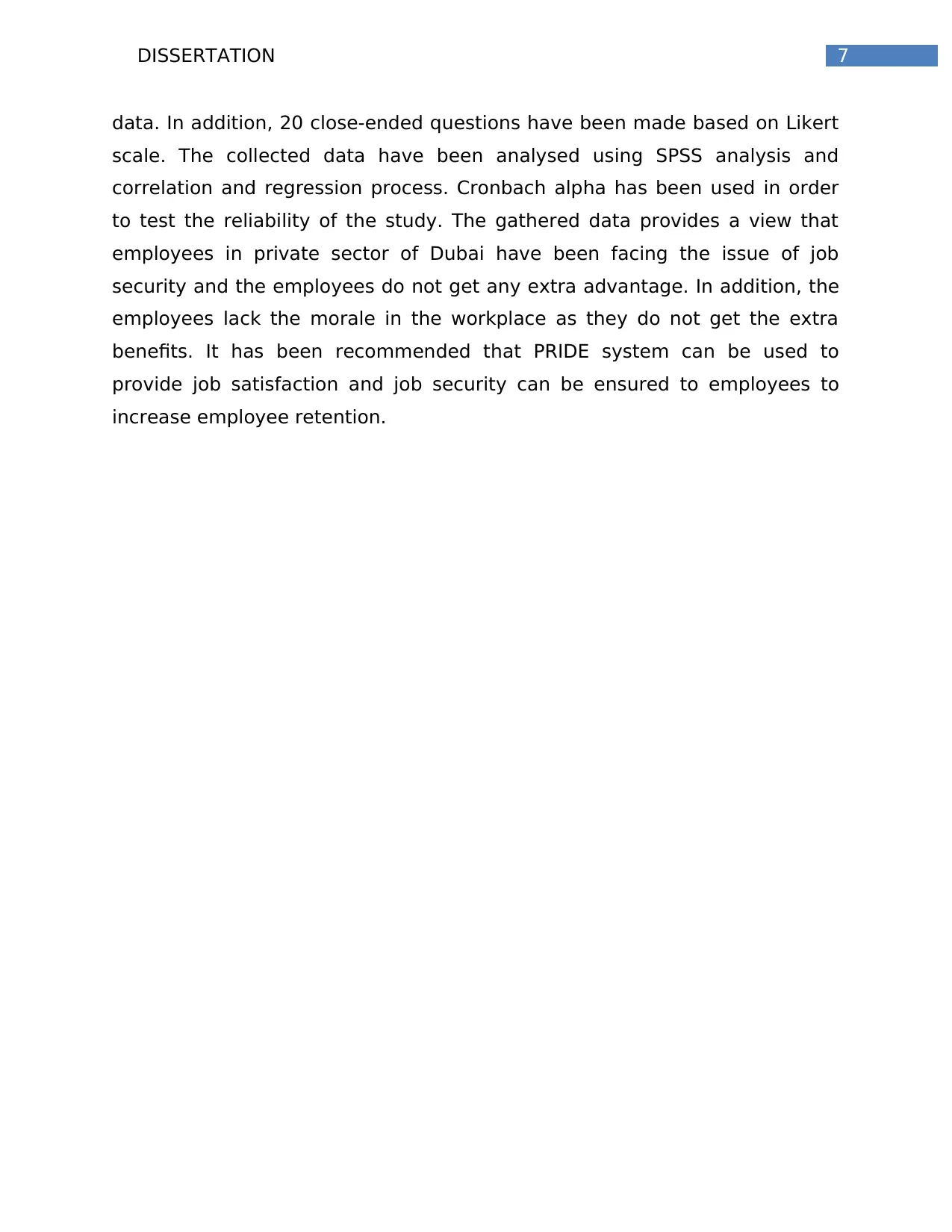
7DISSERTATION
data. In addition, 20 close-ended questions have been made based on Likert
scale. The collected data have been analysed using SPSS analysis and
correlation and regression process. Cronbach alpha has been used in order
to test the reliability of the study. The gathered data provides a view that
employees in private sector of Dubai have been facing the issue of job
security and the employees do not get any extra advantage. In addition, the
employees lack the morale in the workplace as they do not get the extra
benefits. It has been recommended that PRIDE system can be used to
provide job satisfaction and job security can be ensured to employees to
increase employee retention.
data. In addition, 20 close-ended questions have been made based on Likert
scale. The collected data have been analysed using SPSS analysis and
correlation and regression process. Cronbach alpha has been used in order
to test the reliability of the study. The gathered data provides a view that
employees in private sector of Dubai have been facing the issue of job
security and the employees do not get any extra advantage. In addition, the
employees lack the morale in the workplace as they do not get the extra
benefits. It has been recommended that PRIDE system can be used to
provide job satisfaction and job security can be ensured to employees to
increase employee retention.
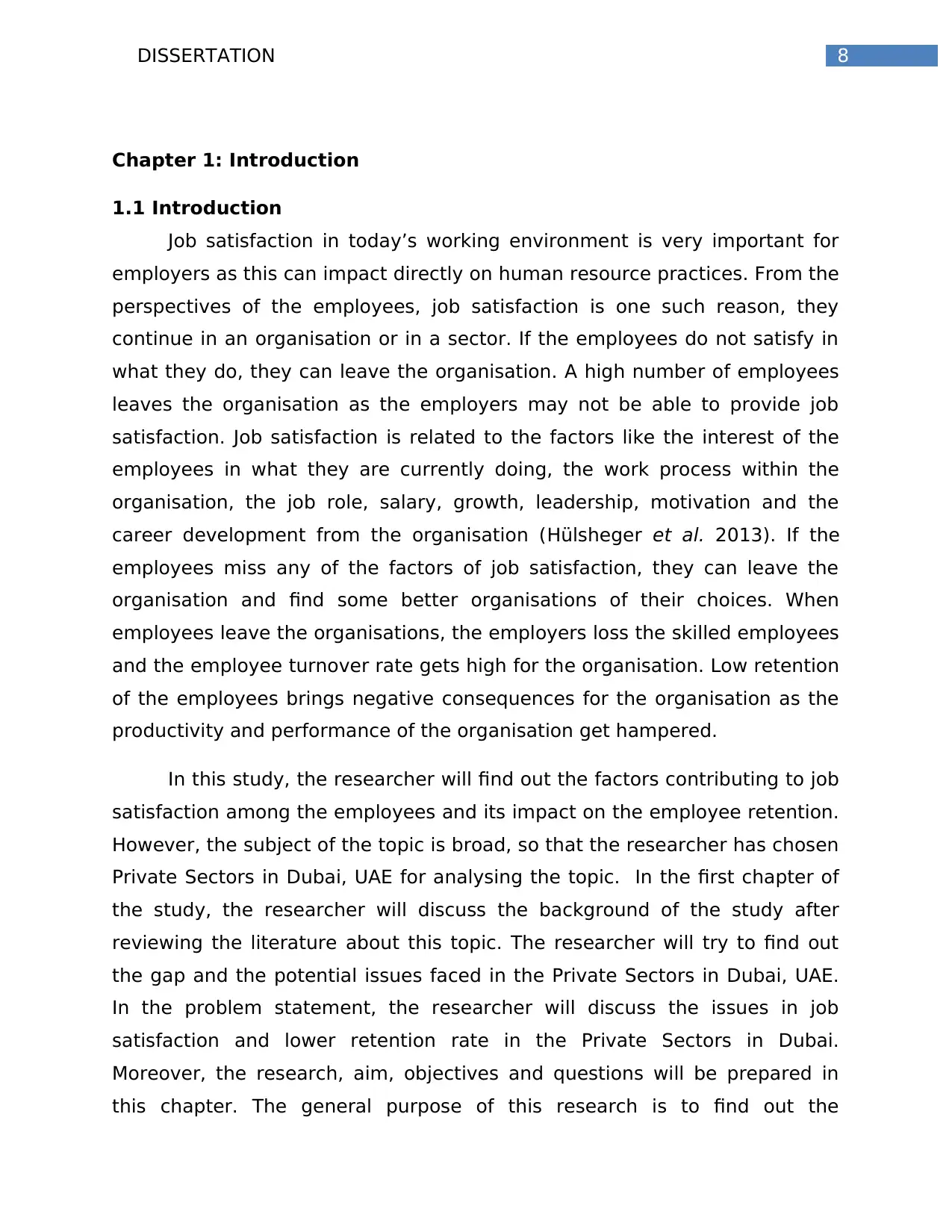
8DISSERTATION
Chapter 1: Introduction
1.1 Introduction
Job satisfaction in today’s working environment is very important for
employers as this can impact directly on human resource practices. From the
perspectives of the employees, job satisfaction is one such reason, they
continue in an organisation or in a sector. If the employees do not satisfy in
what they do, they can leave the organisation. A high number of employees
leaves the organisation as the employers may not be able to provide job
satisfaction. Job satisfaction is related to the factors like the interest of the
employees in what they are currently doing, the work process within the
organisation, the job role, salary, growth, leadership, motivation and the
career development from the organisation (Hülsheger et al. 2013). If the
employees miss any of the factors of job satisfaction, they can leave the
organisation and find some better organisations of their choices. When
employees leave the organisations, the employers loss the skilled employees
and the employee turnover rate gets high for the organisation. Low retention
of the employees brings negative consequences for the organisation as the
productivity and performance of the organisation get hampered.
In this study, the researcher will find out the factors contributing to job
satisfaction among the employees and its impact on the employee retention.
However, the subject of the topic is broad, so that the researcher has chosen
Private Sectors in Dubai, UAE for analysing the topic. In the first chapter of
the study, the researcher will discuss the background of the study after
reviewing the literature about this topic. The researcher will try to find out
the gap and the potential issues faced in the Private Sectors in Dubai, UAE.
In the problem statement, the researcher will discuss the issues in job
satisfaction and lower retention rate in the Private Sectors in Dubai.
Moreover, the research, aim, objectives and questions will be prepared in
this chapter. The general purpose of this research is to find out the
Chapter 1: Introduction
1.1 Introduction
Job satisfaction in today’s working environment is very important for
employers as this can impact directly on human resource practices. From the
perspectives of the employees, job satisfaction is one such reason, they
continue in an organisation or in a sector. If the employees do not satisfy in
what they do, they can leave the organisation. A high number of employees
leaves the organisation as the employers may not be able to provide job
satisfaction. Job satisfaction is related to the factors like the interest of the
employees in what they are currently doing, the work process within the
organisation, the job role, salary, growth, leadership, motivation and the
career development from the organisation (Hülsheger et al. 2013). If the
employees miss any of the factors of job satisfaction, they can leave the
organisation and find some better organisations of their choices. When
employees leave the organisations, the employers loss the skilled employees
and the employee turnover rate gets high for the organisation. Low retention
of the employees brings negative consequences for the organisation as the
productivity and performance of the organisation get hampered.
In this study, the researcher will find out the factors contributing to job
satisfaction among the employees and its impact on the employee retention.
However, the subject of the topic is broad, so that the researcher has chosen
Private Sectors in Dubai, UAE for analysing the topic. In the first chapter of
the study, the researcher will discuss the background of the study after
reviewing the literature about this topic. The researcher will try to find out
the gap and the potential issues faced in the Private Sectors in Dubai, UAE.
In the problem statement, the researcher will discuss the issues in job
satisfaction and lower retention rate in the Private Sectors in Dubai.
Moreover, the research, aim, objectives and questions will be prepared in
this chapter. The general purpose of this research is to find out the
⊘ This is a preview!⊘
Do you want full access?
Subscribe today to unlock all pages.

Trusted by 1+ million students worldwide
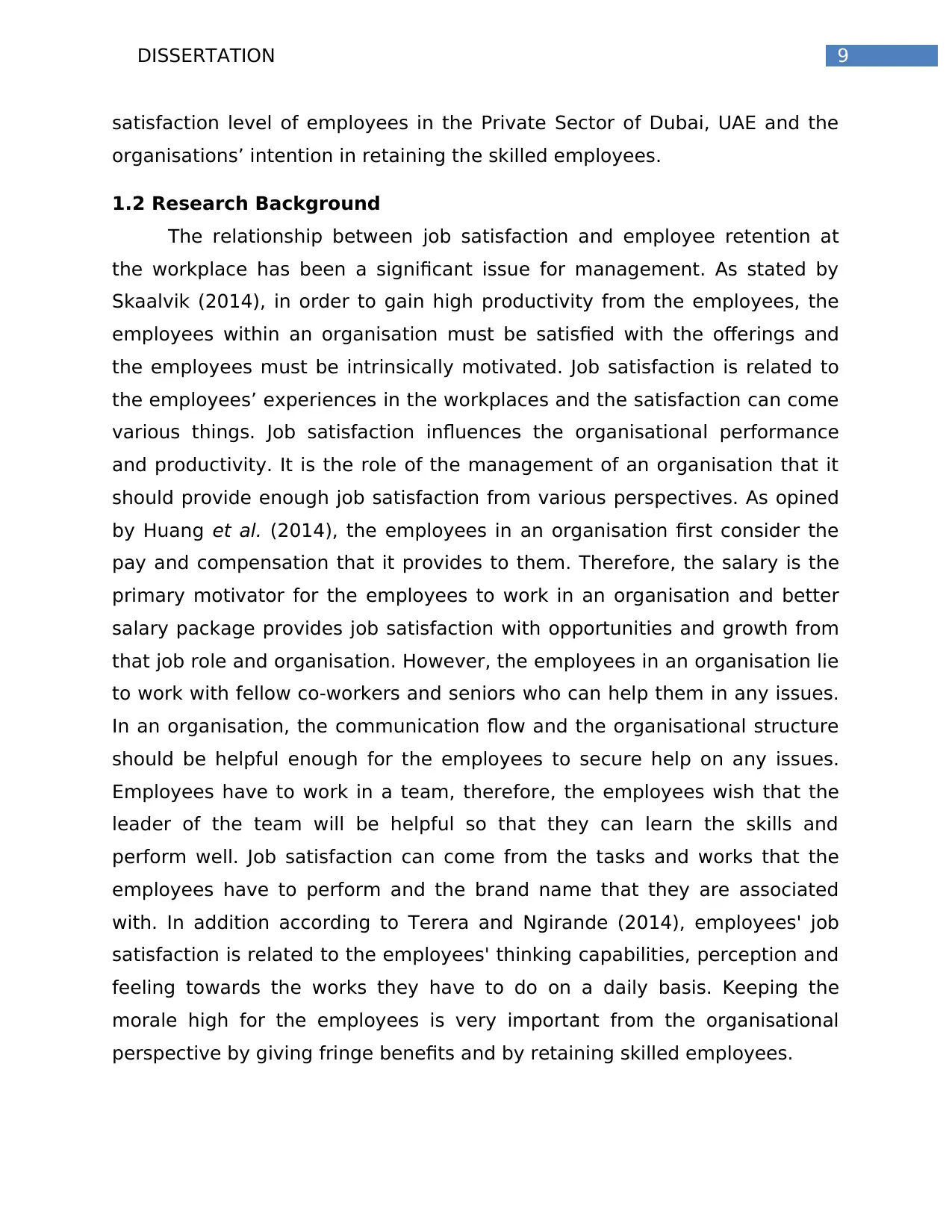
9DISSERTATION
satisfaction level of employees in the Private Sector of Dubai, UAE and the
organisations’ intention in retaining the skilled employees.
1.2 Research Background
The relationship between job satisfaction and employee retention at
the workplace has been a significant issue for management. As stated by
Skaalvik (2014), in order to gain high productivity from the employees, the
employees within an organisation must be satisfied with the offerings and
the employees must be intrinsically motivated. Job satisfaction is related to
the employees’ experiences in the workplaces and the satisfaction can come
various things. Job satisfaction influences the organisational performance
and productivity. It is the role of the management of an organisation that it
should provide enough job satisfaction from various perspectives. As opined
by Huang et al. (2014), the employees in an organisation first consider the
pay and compensation that it provides to them. Therefore, the salary is the
primary motivator for the employees to work in an organisation and better
salary package provides job satisfaction with opportunities and growth from
that job role and organisation. However, the employees in an organisation lie
to work with fellow co-workers and seniors who can help them in any issues.
In an organisation, the communication flow and the organisational structure
should be helpful enough for the employees to secure help on any issues.
Employees have to work in a team, therefore, the employees wish that the
leader of the team will be helpful so that they can learn the skills and
perform well. Job satisfaction can come from the tasks and works that the
employees have to perform and the brand name that they are associated
with. In addition according to Terera and Ngirande (2014), employees' job
satisfaction is related to the employees' thinking capabilities, perception and
feeling towards the works they have to do on a daily basis. Keeping the
morale high for the employees is very important from the organisational
perspective by giving fringe benefits and by retaining skilled employees.
satisfaction level of employees in the Private Sector of Dubai, UAE and the
organisations’ intention in retaining the skilled employees.
1.2 Research Background
The relationship between job satisfaction and employee retention at
the workplace has been a significant issue for management. As stated by
Skaalvik (2014), in order to gain high productivity from the employees, the
employees within an organisation must be satisfied with the offerings and
the employees must be intrinsically motivated. Job satisfaction is related to
the employees’ experiences in the workplaces and the satisfaction can come
various things. Job satisfaction influences the organisational performance
and productivity. It is the role of the management of an organisation that it
should provide enough job satisfaction from various perspectives. As opined
by Huang et al. (2014), the employees in an organisation first consider the
pay and compensation that it provides to them. Therefore, the salary is the
primary motivator for the employees to work in an organisation and better
salary package provides job satisfaction with opportunities and growth from
that job role and organisation. However, the employees in an organisation lie
to work with fellow co-workers and seniors who can help them in any issues.
In an organisation, the communication flow and the organisational structure
should be helpful enough for the employees to secure help on any issues.
Employees have to work in a team, therefore, the employees wish that the
leader of the team will be helpful so that they can learn the skills and
perform well. Job satisfaction can come from the tasks and works that the
employees have to perform and the brand name that they are associated
with. In addition according to Terera and Ngirande (2014), employees' job
satisfaction is related to the employees' thinking capabilities, perception and
feeling towards the works they have to do on a daily basis. Keeping the
morale high for the employees is very important from the organisational
perspective by giving fringe benefits and by retaining skilled employees.
Paraphrase This Document
Need a fresh take? Get an instant paraphrase of this document with our AI Paraphraser

10DISSERTATION
Job satisfaction is associated with the idea how employees' feelings
about their job and if the satisfaction criteria are not matching with the
employees' level, they eventually leave the organisation (Aruna and Anitha
2015). The organisation management facilitates the ideas of motivations in
the workplace so that the employees must not leave the organisation,
especially the experienced and skilled employees. High turnover rate of the
employees does harm an organisation's reputation and the management
needs to seek new employees always. Organisational culture, workplace
motivation, salary and communication can improve the job satisfaction and
the employees keep themselves in the organisations. High retentions can
increase organisational profitability and it boosts the morale of the
employees and the management does not need to find alternative staff
replacement policy (Hayes et al. 2015). Therefore, when the level of
satisfaction increases for the employees, they will be in the organisations,
whereas, employees' dissatisfaction can put adverse effects on the
organisations. There are several factors for creating an enjoyable workplace
for the employees; however, the management needs to take a distinct
approach for this.
Overview of Private Sector in Dubai, UAE
Private Sector in Dubai, UAE is comprised of two types, one is oil based
private sector and another one is a non-oil private sector. Of late, the private
sector is driven by steep expansion for increasing the output of the business
(Harara et al. 2015). In this regard, apart from oil, there are other
organisations like real estate, construction, bank and accounting, supply
chain based companies, travel and tourism companies, automobile
companies and pharmaceutical companies. Dubai Economy Tracker Index
has forecasted that economy in private sector will be seen high growth rate.
The latest finding in the Dubai Private Sector has exposed that Dubai Private
Sector is going through the best economic times in consecutive last 19
months (Gulfnews.com 2017). Many of the companies hire from others
Job satisfaction is associated with the idea how employees' feelings
about their job and if the satisfaction criteria are not matching with the
employees' level, they eventually leave the organisation (Aruna and Anitha
2015). The organisation management facilitates the ideas of motivations in
the workplace so that the employees must not leave the organisation,
especially the experienced and skilled employees. High turnover rate of the
employees does harm an organisation's reputation and the management
needs to seek new employees always. Organisational culture, workplace
motivation, salary and communication can improve the job satisfaction and
the employees keep themselves in the organisations. High retentions can
increase organisational profitability and it boosts the morale of the
employees and the management does not need to find alternative staff
replacement policy (Hayes et al. 2015). Therefore, when the level of
satisfaction increases for the employees, they will be in the organisations,
whereas, employees' dissatisfaction can put adverse effects on the
organisations. There are several factors for creating an enjoyable workplace
for the employees; however, the management needs to take a distinct
approach for this.
Overview of Private Sector in Dubai, UAE
Private Sector in Dubai, UAE is comprised of two types, one is oil based
private sector and another one is a non-oil private sector. Of late, the private
sector is driven by steep expansion for increasing the output of the business
(Harara et al. 2015). In this regard, apart from oil, there are other
organisations like real estate, construction, bank and accounting, supply
chain based companies, travel and tourism companies, automobile
companies and pharmaceutical companies. Dubai Economy Tracker Index
has forecasted that economy in private sector will be seen high growth rate.
The latest finding in the Dubai Private Sector has exposed that Dubai Private
Sector is going through the best economic times in consecutive last 19
months (Gulfnews.com 2017). Many of the companies hire from others
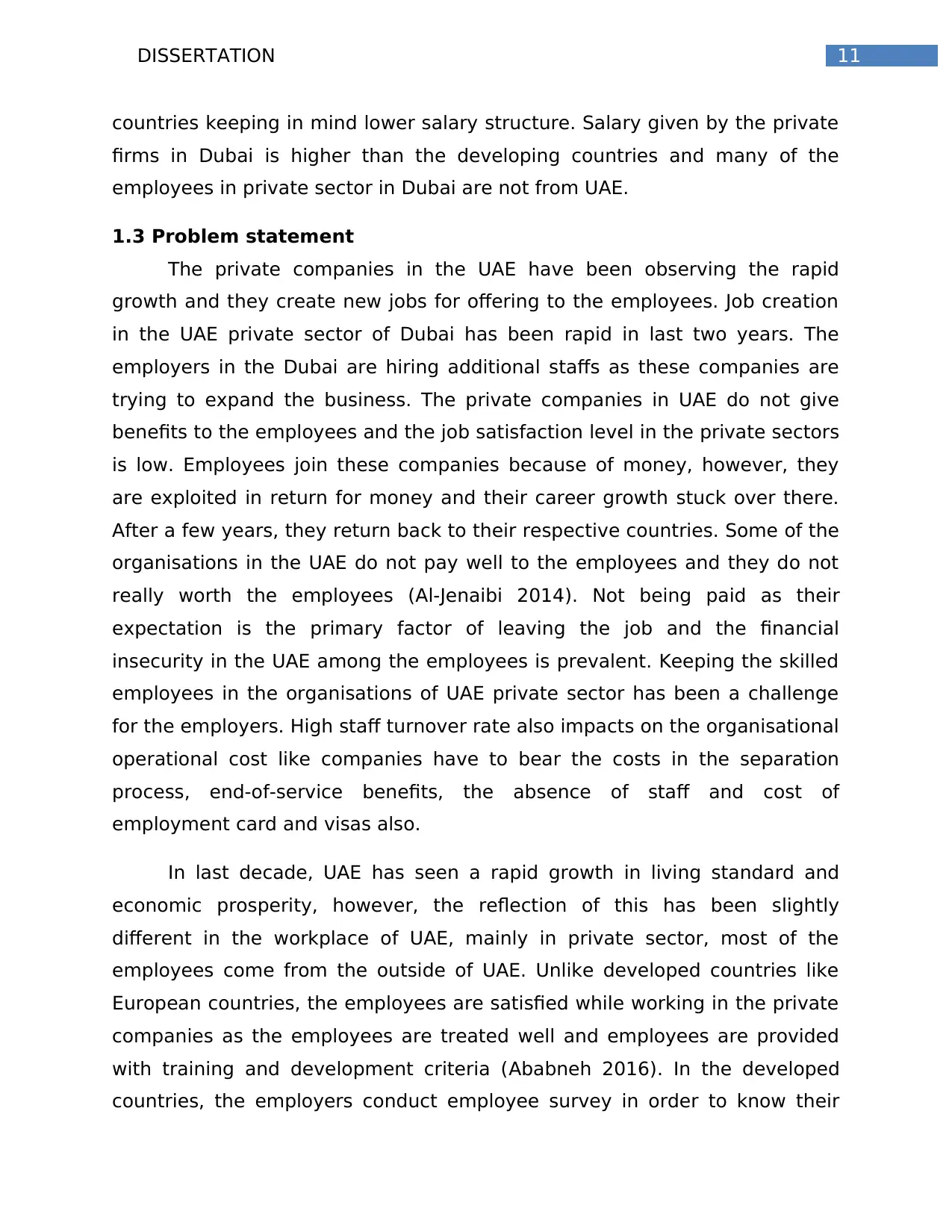
11DISSERTATION
countries keeping in mind lower salary structure. Salary given by the private
firms in Dubai is higher than the developing countries and many of the
employees in private sector in Dubai are not from UAE.
1.3 Problem statement
The private companies in the UAE have been observing the rapid
growth and they create new jobs for offering to the employees. Job creation
in the UAE private sector of Dubai has been rapid in last two years. The
employers in the Dubai are hiring additional staffs as these companies are
trying to expand the business. The private companies in UAE do not give
benefits to the employees and the job satisfaction level in the private sectors
is low. Employees join these companies because of money, however, they
are exploited in return for money and their career growth stuck over there.
After a few years, they return back to their respective countries. Some of the
organisations in the UAE do not pay well to the employees and they do not
really worth the employees (Al-Jenaibi 2014). Not being paid as their
expectation is the primary factor of leaving the job and the financial
insecurity in the UAE among the employees is prevalent. Keeping the skilled
employees in the organisations of UAE private sector has been a challenge
for the employers. High staff turnover rate also impacts on the organisational
operational cost like companies have to bear the costs in the separation
process, end-of-service benefits, the absence of staff and cost of
employment card and visas also.
In last decade, UAE has seen a rapid growth in living standard and
economic prosperity, however, the reflection of this has been slightly
different in the workplace of UAE, mainly in private sector, most of the
employees come from the outside of UAE. Unlike developed countries like
European countries, the employees are satisfied while working in the private
companies as the employees are treated well and employees are provided
with training and development criteria (Ababneh 2016). In the developed
countries, the employers conduct employee survey in order to know their
countries keeping in mind lower salary structure. Salary given by the private
firms in Dubai is higher than the developing countries and many of the
employees in private sector in Dubai are not from UAE.
1.3 Problem statement
The private companies in the UAE have been observing the rapid
growth and they create new jobs for offering to the employees. Job creation
in the UAE private sector of Dubai has been rapid in last two years. The
employers in the Dubai are hiring additional staffs as these companies are
trying to expand the business. The private companies in UAE do not give
benefits to the employees and the job satisfaction level in the private sectors
is low. Employees join these companies because of money, however, they
are exploited in return for money and their career growth stuck over there.
After a few years, they return back to their respective countries. Some of the
organisations in the UAE do not pay well to the employees and they do not
really worth the employees (Al-Jenaibi 2014). Not being paid as their
expectation is the primary factor of leaving the job and the financial
insecurity in the UAE among the employees is prevalent. Keeping the skilled
employees in the organisations of UAE private sector has been a challenge
for the employers. High staff turnover rate also impacts on the organisational
operational cost like companies have to bear the costs in the separation
process, end-of-service benefits, the absence of staff and cost of
employment card and visas also.
In last decade, UAE has seen a rapid growth in living standard and
economic prosperity, however, the reflection of this has been slightly
different in the workplace of UAE, mainly in private sector, most of the
employees come from the outside of UAE. Unlike developed countries like
European countries, the employees are satisfied while working in the private
companies as the employees are treated well and employees are provided
with training and development criteria (Ababneh 2016). In the developed
countries, the employers conduct employee survey in order to know their
⊘ This is a preview!⊘
Do you want full access?
Subscribe today to unlock all pages.

Trusted by 1+ million students worldwide
1 out of 98
Related Documents
Your All-in-One AI-Powered Toolkit for Academic Success.
+13062052269
info@desklib.com
Available 24*7 on WhatsApp / Email
![[object Object]](/_next/static/media/star-bottom.7253800d.svg)
Unlock your academic potential
Copyright © 2020–2025 A2Z Services. All Rights Reserved. Developed and managed by ZUCOL.





